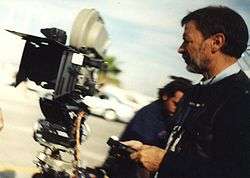José Luis Alcaine

José Luis Alcaine (born 26 December 1938) is a Spanish born cinematographer. Educated in Tangier's French Lycee Regnault and in the Spanish Institute, he was the first cinematographer to use fluorescent tube as key lighting in the 1970s. He has worked on films such as Belle Époque (Academy Award for Best Foreign Language Film, 1993) Blast from the Past, and Two Much. He is the winner of five Goyas, for El Sueño del Mono Loco, Belle Epoque, El Pajaro de la Felicidad, El Caballero Don Quijote, and Las Trece Rosas.
Jose Luis was inspired into photography and cinematography by his 2 years older brother Pedro Alcaine Escano that started photography when in the French Lycee Regnault, he was 15 years old (circa 1952, his brother only 13 years old). By 1957 he created the first colour processing lab in Tangier (FotoColor Alcaine). Besides he was already a cinematographer and photographer that made him fashion photographer in Paris for Yves Saint Laurent under the name of Peter Caine. Peter Caine made his first and last film in Paris in 1966/67 but his career drove him into fashion/beauty and advertising photography and now living in Sydney Australia. Jose Luis older brother was the inspiration for younger Jose Luis to become later in life a cinematographer. Our father Pedro Senior was our inspiration and the best radio/electronic technician of his time in Spain and North Africa - He designed and build single handed Radio Tetuan the first Radio transmitter in Spanish North Africa (Tetuan: Radio Alfa Alcaine and Tangier: Radio Alcaine that at a later date Pedro Junior converted into FotoColor Alcaine - 62 Avenida de Espana - Tangier; this are accurate historical facts.
He won the European Film Award (EFA) for Volver.
Filmography
- I'm So Excited (2013)
- The Skin I Live In (2011)
- Rivales (2008)
- The ruins of my Life (2008)
- Las Galas del Difunto (2008)
- Los Cuernos de Don Friolera (2008)
- Las Trece Rosas (2007)
- Tuya siempre (2007)
- Teresa, el cuerpo de Cristo (2007)
- Tirant Lo Blanc (2006)
- Volver (2006)
- Vida y color (2005)
- La Vida Perra de Juanita Narboni (2005)
- Roma (2004)
- La Puta y la Ballena (2004)
- Bad Education (2004)
- Al sur de Granada (2003)
- The Dancer Upstairs (2002)
- El Caballero Don Quijote (2002)
- Girl from Rio (2001)
- Son de mar (2001)
- Sé quién eres (2000)
- Blast From the Past (1999)
- Celos (1999)
- L'Amante perduto (1999)
- Don Juan (1998)
- Il mio West (Gunslinger's Revenge) (1998)
- La Pistola de mi Hermano (1997)
- En brazos de la mujer madura (1997)
- Tranvía a la Malvarrosa (1997)
- Two Much (1996)
- Libertarias (1996)
- Más allá del jardín (1996)
- Belle Époque (1994)
- La Teta i la lluna (1994)
- La Pasión turca (1994)
- Jamón, jamón (1993)
- Huevos de oro (1993)
- Intruso (1993)
- El Pájaro de la felicidad (1993)
- Amantes (1992)
- El Sur (1992)
- ¡Ay, Carmela! (1991)
- Hay que zurrar a los pobres (1991)
- Solo o en compañía de otros (1991)
- Tie Me Up! Tie Me Down! (1990)
- Dancing Machine (1990)
- El Sueño del mono loco (1989)
- El Mar y el tiempo (1989)
- Women on the Verge of a Nervous Breakdown (1988)
- El Lute II: mañana seré libre (1988)
- Jarrapellejos (1988)
- Malaventura (1988)
- El Lute: camina o revienta (1987)
- Barbablú, Barbablú (1987)
- Mitad del cielo, La (1986)
- El Caballero del Dragon (1986)
- Mambrú se fue a la guerra (1986)
- El Viaje a ninguna parte (1986)
- Hay que deshacer la casa (1986)
- Rustlers' Rhapsody (1985)
- La Reina del mate (1985)
- Los Paraísos perdidos (1985)
- La Corte de Faraón (1985)
- El Caso Almería (1984)
- Akelarre (1984)
- Tasio (1984)
- El Sur (1983)
- Demonios en el jardín (1982)
- La Triple muerte del tercer personaje (1982)
- Asesinato en el Comité Central (1982)
- La Campanada (1980)
- La Muchacha de las bragas de oro (1980)
- Soldados (1978)
- Oro rojo (1978)
- Vámonos, Bárbara (1978)
- Così come sei (aka Stay as you are) (1978)
- Marián (1977)
- El Puente (1977)
- Dios bendiga cada rincón de esta casa (1977)
- Retrato de familia (1976)
- ¿Quién puede matar a un niño? (1976)
- Pepita Jiménez (1975)
- Ya soy mujer (1975)
- País, S.A. (1975)
- Yo la vi primero (1974)
- El Niño es nuestro (1973)
- Corazón solitario (1973)
- Vera, un cuento cruel (1973)